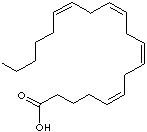PRODUCT IDENTIFICATION

H.S. CODE
TOXICITY
CLASSIFICATION
EXTRA NOTES
PHYSICAL AND CHEMICAL PROPERTIES (40% in EtOH)
AUTOIGNITION
NFPA RATINGS
REFRACTIVE INDEX
EXTERNAL LINKS & GENERAL DESCRIPTION
http://www.sigmaaldrich.com/
Arachidonic acid (AA) is an unsaturated ��6 fatty acid constituent
of the phospholipids of cell membranes. Phospholipase A2 releases AA from the
membrane phospholipids in response to inflammation. AA is subsequently
metabolized to prostaglandins and thromboxanes by at least two cyclooxygenase
(COX) isoforms, to leukotrienes and lipoxins by lipoxygenases, and to
epoxyeicosatrienoic acids via cytochrome p450-catalyzed metabolism. AA and its
metabolites play important roles in a variety of biological processes, including
signal transduction, smooth muscle contraction, chemotaxis, cell proliferation
and differentiation, and apoptosis. AA has been demonstrated to bind to the a
subunit of G protein and inhibit the activity of Ras GTPase-activating proteins
(GAPs). Cellular uptake of AA is energy dependent and involves
protein-facilitated transport across the plasma membrane.
http://www.acnp.org/
In resting cells, arachidonic acid is stored within the cell membrane,
esterified to glycerol in phospholipids. A receptor-dependent event, requiring a
transducing G protein, initiates phospholipid hydrolysis and releases the fatty
acid into the intracellular medium. Three enzymes may mediate this deacylation
reaction: phospholipase A2 (PLA2),
phospholipase C (PLC), and phospholipase D (PLD), whose different sites of
attack on the phospholipid backbone are shown in Fig. 2 (inset). PLA2 catalyzes
the hydrolysis of phospholipids at the sn (stereospecific numbering)-2 position.
Therefore, this enzyme can release arachidonate in a single-step reaction. By
contrast, PLC and PLD do not release free arachidonic acid directly. Rather,
they generate lipid products containing arachidonate (diacylglycerol and
phosphatidic acid, respectively), which can be released subsequently by
diacylglycerol- and monoacylglycerol-lipases
Local: Arachidonic acid is a polyunsaturated fatty acid (C-20 with four cis double bonds) and considered as a essential fatty acid; occurring in animal fats and also formed by biosynthesis from dietary linoleic acid. It is a precursor of eicosanoids which are biologically, physiologically and pathologically active on the cardiovascular, pulmonary, reproductive, and digestive systems as local hormones; including prostaglandins, thromboxanes, leukotrienes, and epoxyeicosatrienoic acids (EETs).
PEROXIDE
40 mg/kg
HEAVY METALS
PRICE INFORMATION